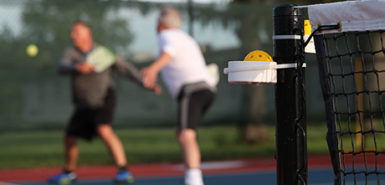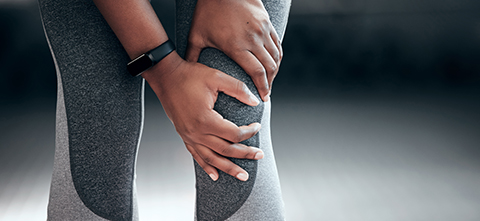
It’s a feeling that all too many runners are familiar with—an aching pain in the knee that typically gets worse with every step.
Called runner’s knee, or patellofemoral pain syndrome, it’s something Matthew Axtman, DO, a Corewell Health orthopedic sports medicine specialist, sees in a lot of patients.
“Knee pain is one of the most common complaints in runners,” Dr. Axtman said.
Many of those patients are surprised to learn from Dr. Axtman that the pain’s cause might actually be somewhere other than the knee.
“The knee joint is between the hip and the ankle, so it’s going to be the workhorse between both of those areas,” Dr. Axtman said.
There could be muscle imbalances in the leg from the hip to the ankle that may contribute to abnormal mechanics and cause pain.
Or maybe the way a runner’s foot hits the ground creates a problematic gait, causing knee pain. Or perhaps the hip or thigh muscles—or even the abdominal and core muscles—are weak or tight, and stressing the knee.
“Most of it has to do with imbalances with how everything is pushing and pulling,” Dr. Axtman said. “It’s just like if your car is out of alignment. It’s going to pull to one side. If your body is out of alignment, it’s going to alter how your leg is working.”
He said he sometimes gets strange looks from patients who have come in for knee pain, and they end up talking about areas above or below the joint.
“I might say, ‘I know you have knee pain, but I don’t think it’s your knee that’s to blame. I think it’s your hip,’” Dr. Axtman said. “I will get this deer in the headlights look.”
That’s why it’s important to be evaluated by a medical professional, he said. Every patient is different, including anatomy, genetics and more, and a doctor specializing in knee pain can help sort that out.
Dr. Axtman offered these tips for runners—and walkers—to avoid knee pain:
Don’t run every day
To drive this point home, Dr. Axtman again uses a car analogy: NASCAR cars go around and around the track at high speeds, but they also need pit stops to change their tires.
“You’re doing the exact same thing when you exclusively run. You take away the focus from other muscles that you are not working enough,” he explained. “That means those muscles shut down and that can lead to pain.”
Taking pit stops from running can help prevent that.
“Take at least one rest day per week, if not two,” Dr. Axtman said. “You have to allow your body to recuperate.”
Focus on cross-training
Make sure to strengthen all the body’s muscle groups by cross-training. That means that instead of running, some days try cycling, using an elliptical machine, swimming, Pilates or weight training.
“That way you are targeting the overall body so that you are hitting a whole bunch of muscle groups,” Dr. Axtman said. “Not cross-training can likely lead to pain and injury because you are not making sure that everything is working well together.”
Try home care
If you experience knee pain, try home care for a few weeks. If that does not work, see a medical professional.
If you start to feel discomfort or pain in your knee, try applying ice, taking anti-inflammatory medications such as ibuprofen, and back down on exercising for a little while, Dr. Axtman said.
“Sometimes (knee pain) can resolve on its own,” he said.
But if a few weeks go by and it doesn’t improve, or if it comes back as soon as you return to running, it’s time to see a doctor.
“That’s when you have to make sure you get evaluated,” Dr. Axtman said. “What you don’t want to do is blow things off and push through the pain, because that puts you at risk for further injury.”
Other red flags that should be evaluated right away: knee swelling, locking, or the feeling that your knee is going to give out, he said.
Start smart
If you’re beginning a new walking or running routine, starting with smart practices can help prevent knee pain down the line, he said.
First, set your goals. Do you want to lose weight, get in better shape, get more cardiovascular activity, train for a race, or something else?
“Depending on what your goals are, you’re going to have different plans,” Dr. Axtman said.
He advises researching reputable sources for training plans online. For instance, you can research couch-to-5K plans, walking to lose weight or training for a marathon. He also advises writing your plan down and finding a way to track your progress toward that goal.
Finding a partner to train alongside you also helps. It’s more fun and it keeps you accountable, he said.
Also, start with a good pair of shoes. Patients ask him all the time what the best running or walking shoe is, and he always says it depends.
“Everybody is different,” he said.
Dr. Axtman wears one brand of shoe to work every day, but he cannot run in that same brand.
Some local running shoe stores will help you find the correct fit. Many of these stories have an exchange program in case the shoes you purchase don’t work once you try them out.
Be careful, and don’t let knee pain sideline you from running or walking.
“It’s a simple thing,” he said. “It’s a practically free activity, and you can do it anywhere … inside, outside as long as it’s not icy, and whenever you want to.”
 /a>
/a>
 /a>
/a>
 /a>
/a>